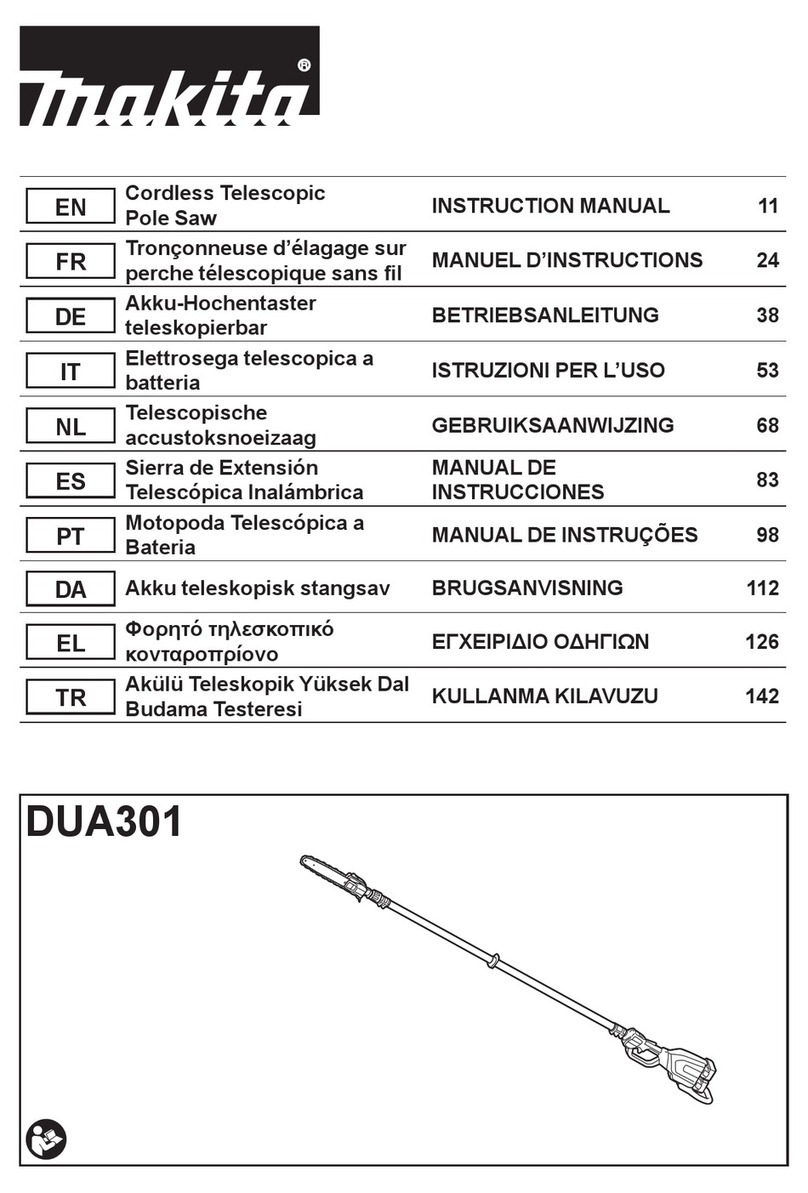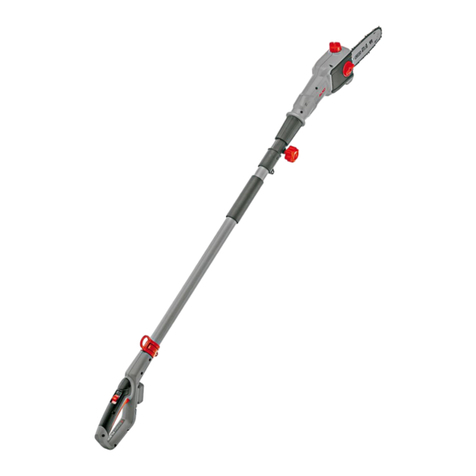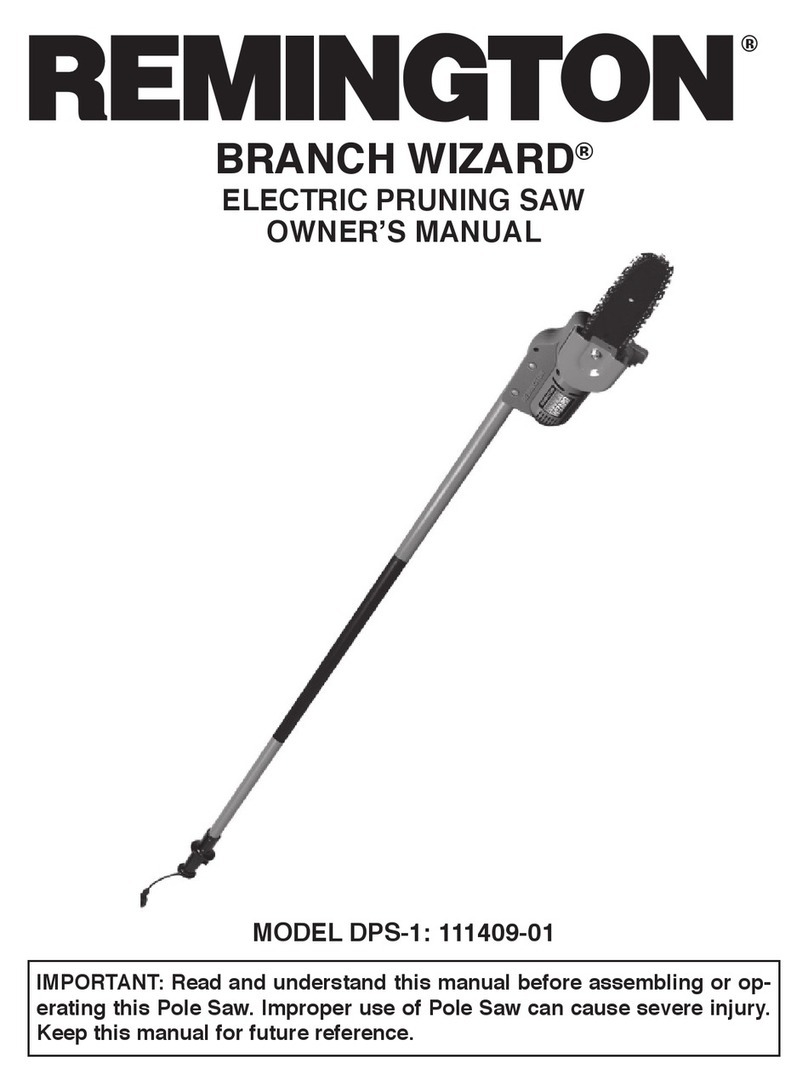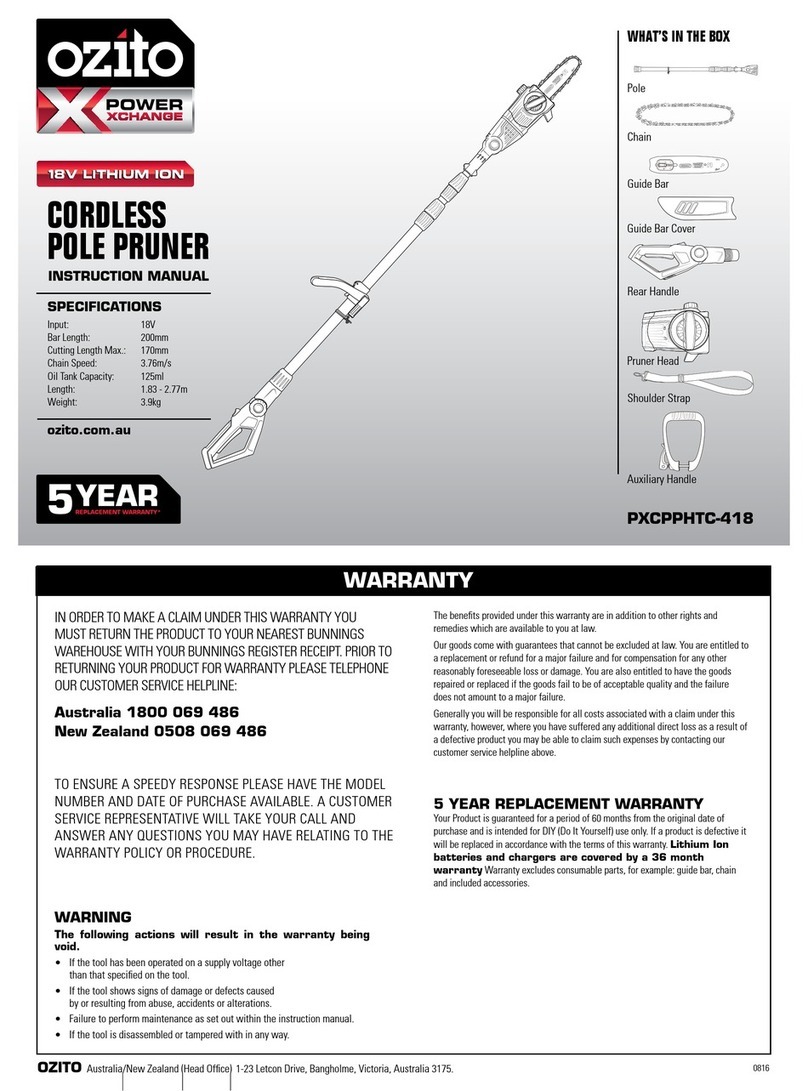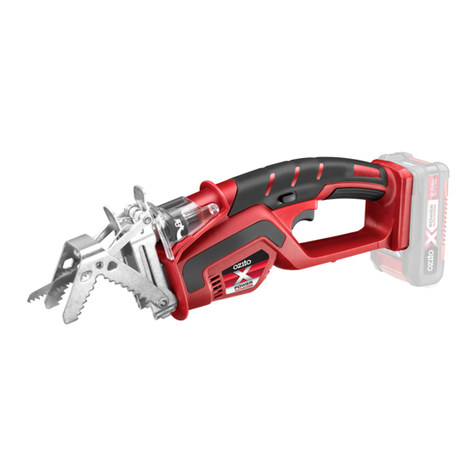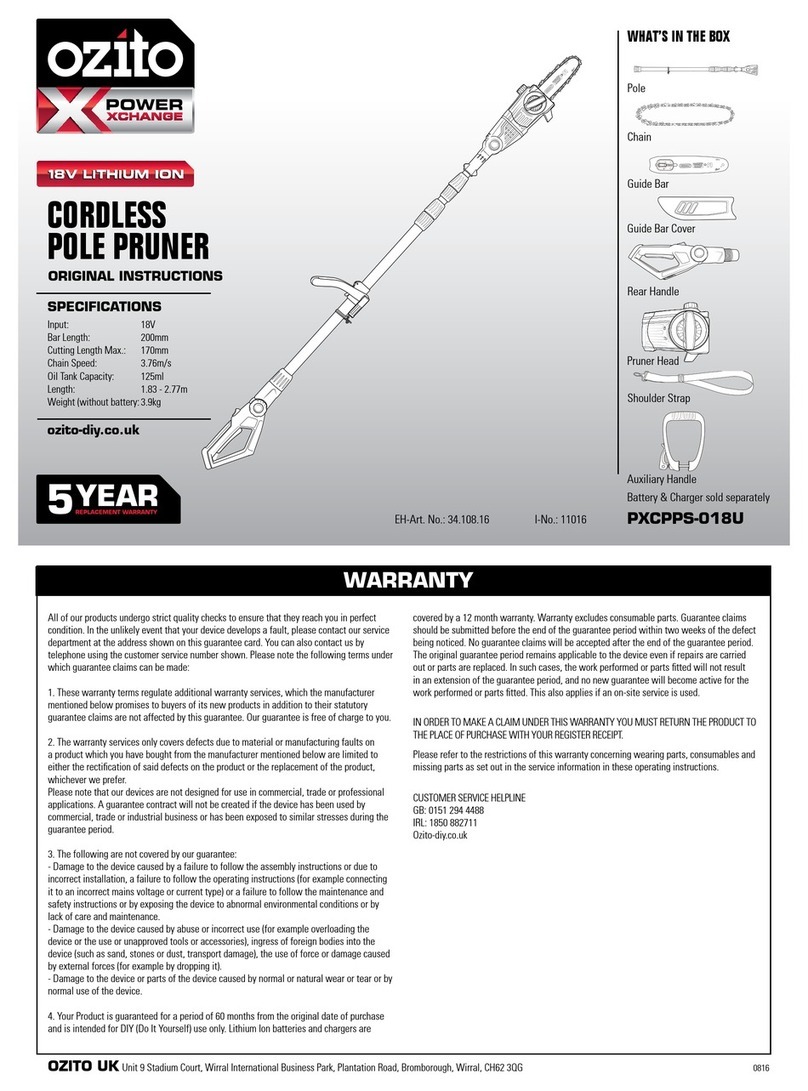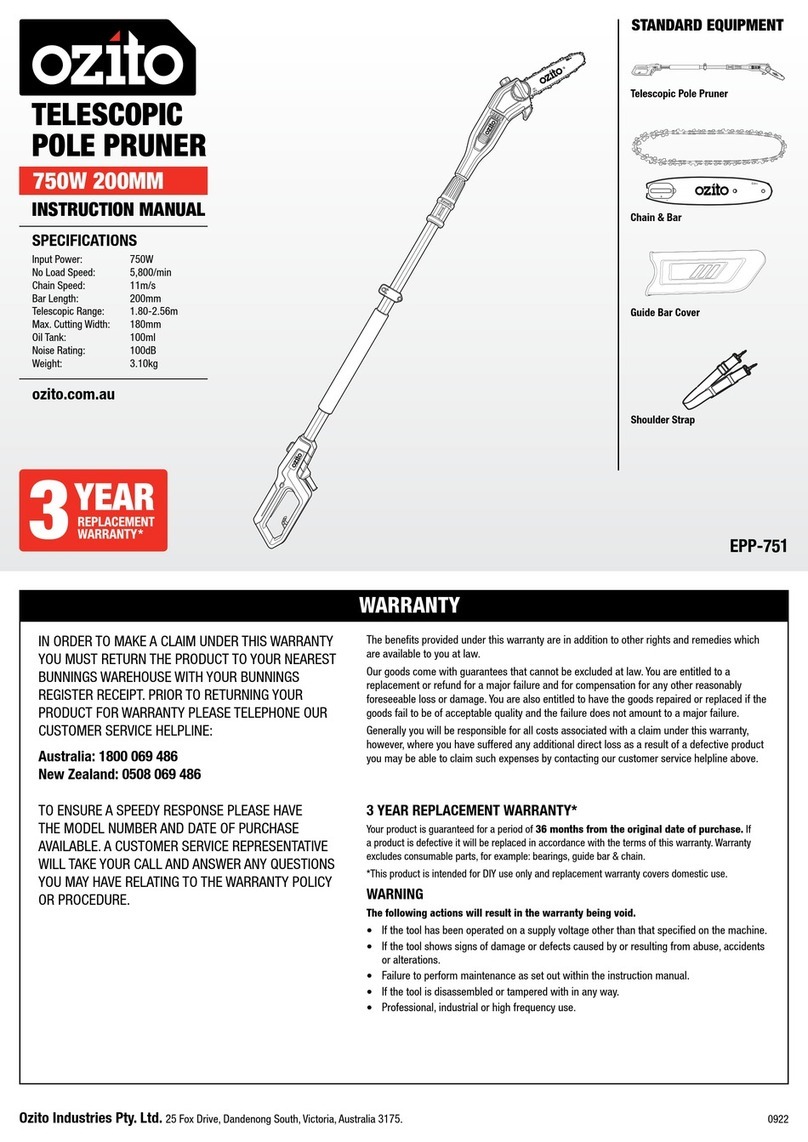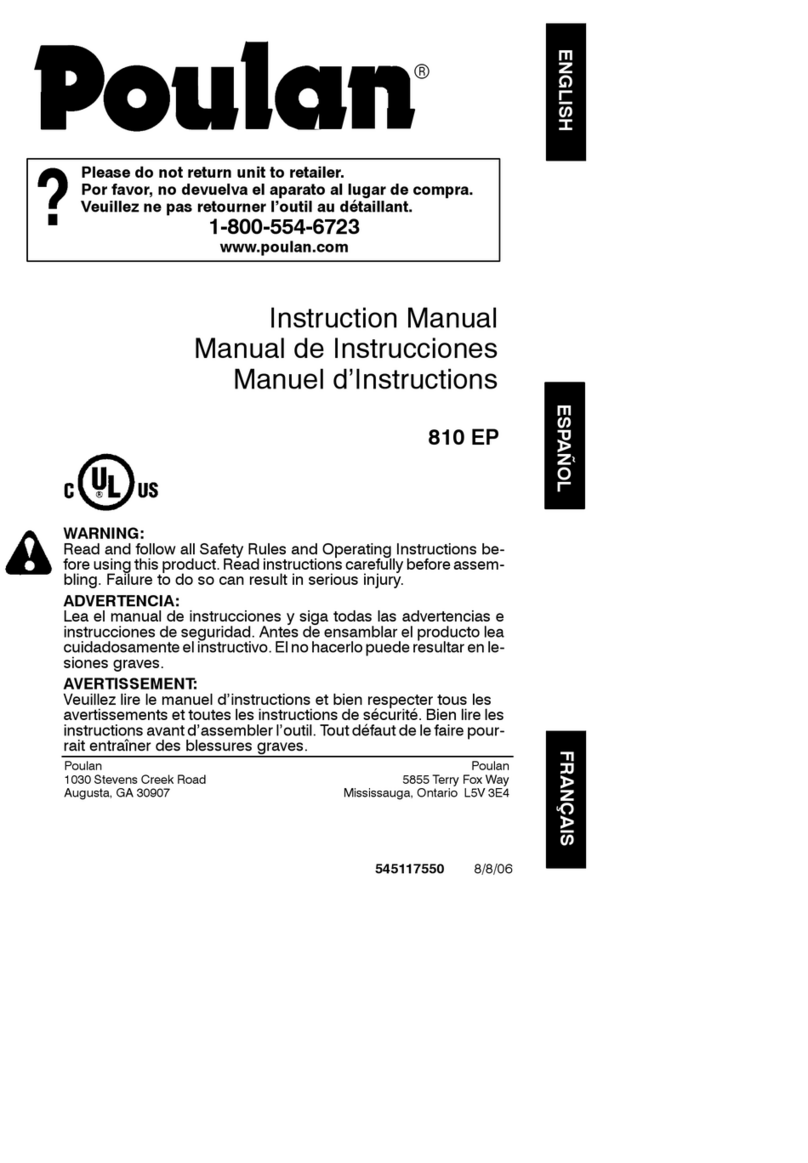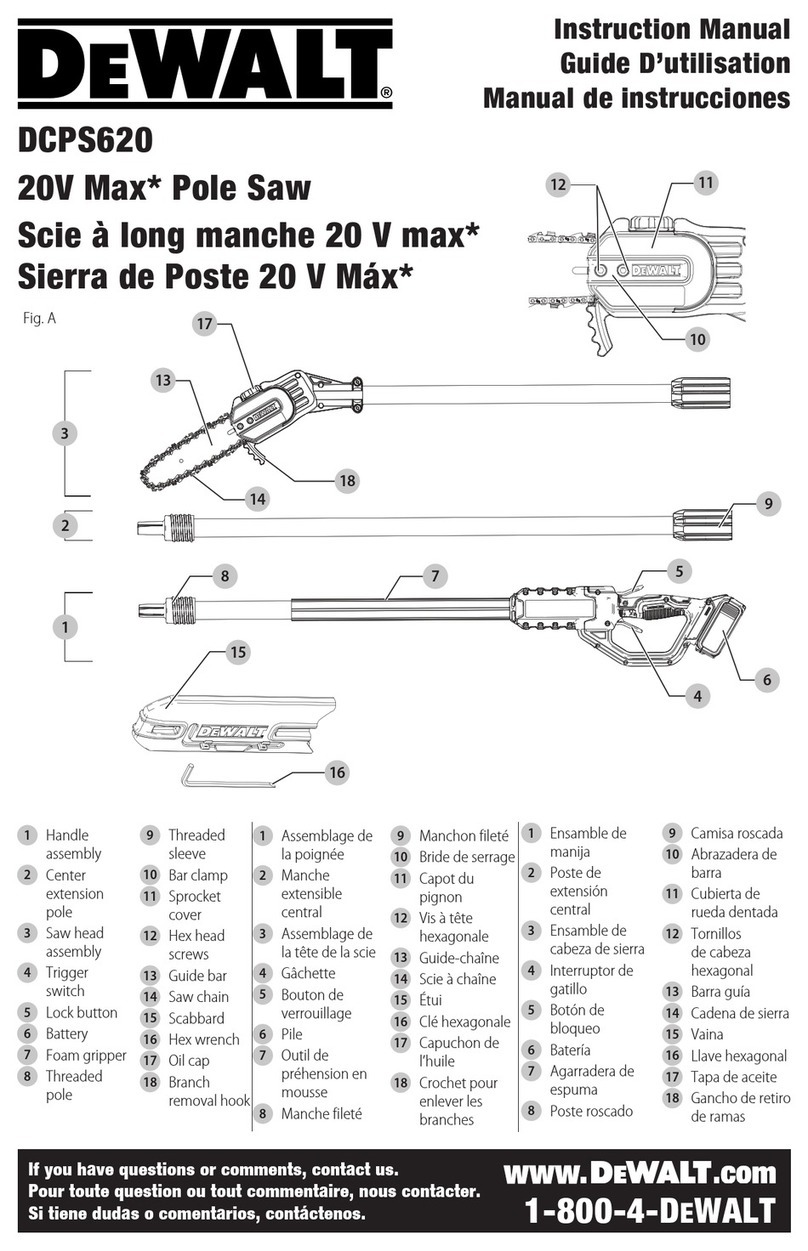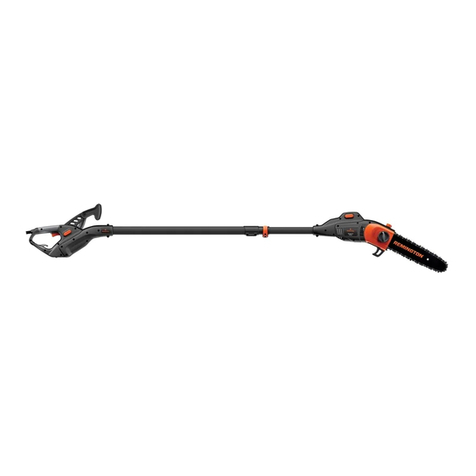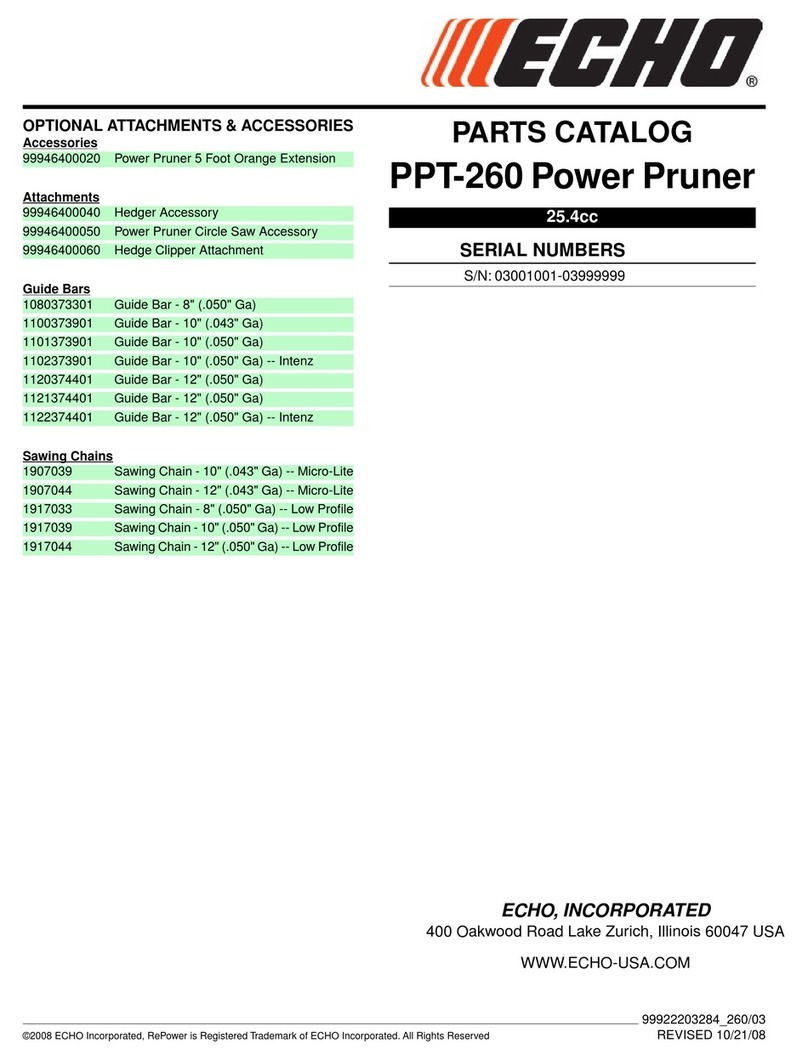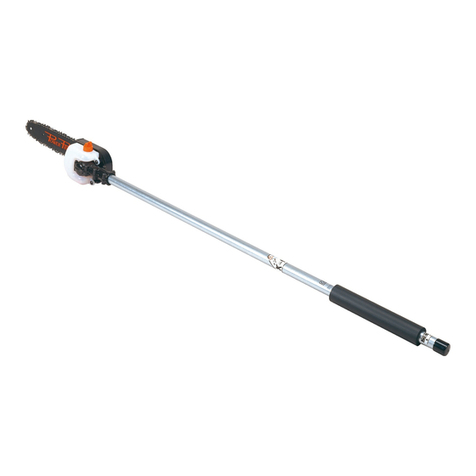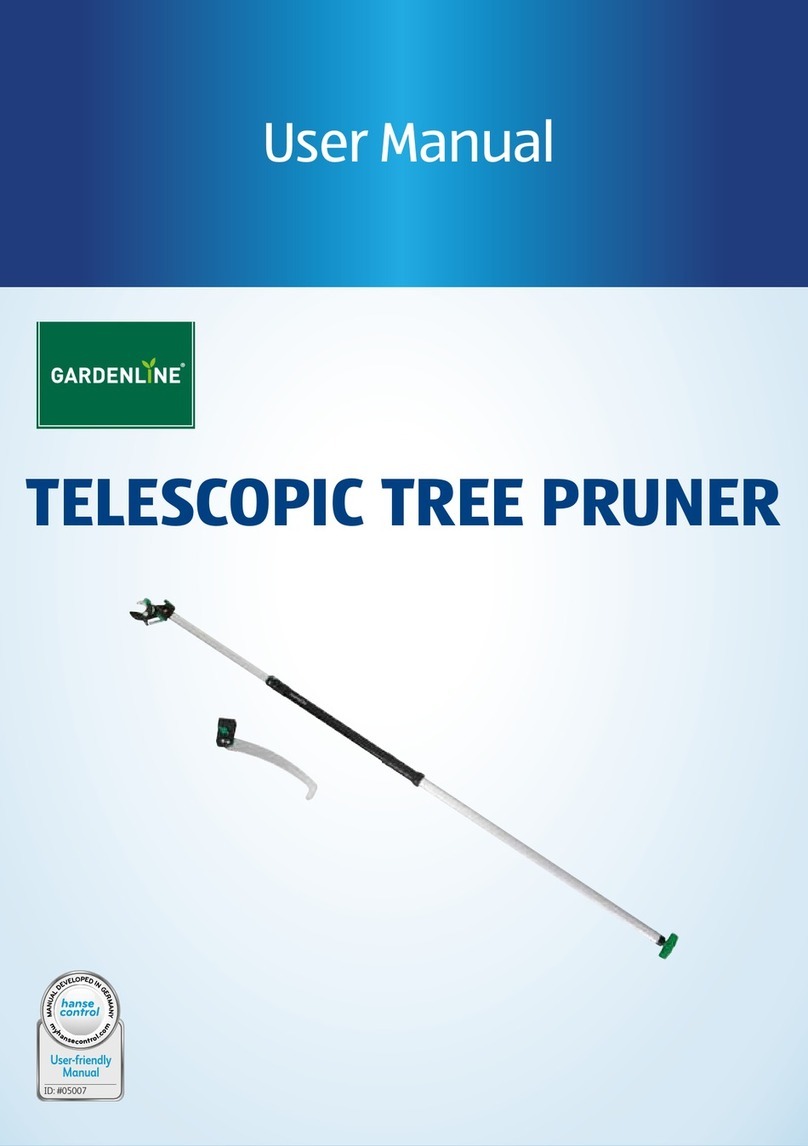
GENERAL MACHINE SAFETY WARNINGS
ELECTRICAL SAFETY
POLE PRUNER SAFETY WARNINGS
WARNING! When using electric machines, basic safety precautions, including
the following, should always be followed to reduce risk of fire, electric shock, personal
injury and material damage.
-Read the whole manual carefully and make sure you know how to switch the machine off in an
emergency, before operating the machine. Save these instructions and other documents supplied
with this machine for future reference.
-This appliance is not intended for use by persons (including children) with reduced physical,
sensory or mental capabilities, or lack of experience and knowledge, unless they have been given
supervision or instruction concerning use of the appliance by a person responsible for their safety.
Children should be supervised to ensure that they do not play with the appliance.
-This appliance is compatible and only to be used with all batteries & chargers from the Ozito PXC
range. Refer to the PXC battery and charger manuals for information regarding charging, use and
storage.
-Remove the batteries from the appliance before being charged.
-Do not combine different types of batteries or new and used batteries.
-If the appliance is to be stored unused for a long period, the batteries should be removed.
-Do not use modified or damaged batteries.
WARNING! Read all safety warnings, instructions, illustrations and
specifications provided with this machine. Failure to follow all instructions listed below
may result in electric shock, fire and/or serious injury.
Save all warnings and instructions for future reference.
The term “machine” in the warnings refers to your mains-operated (corded) machine or battery-
operated (cordless) machine.
1) Work area safety
a) Keep work area clean and well lit. Cluttered or dark areas invite accidents.
b) Do not operate machines in explosive atmospheres, such as in the presence of flammable
liquids, gases or dust. Machines create sparks which may ignite the dust or fumes.
c) Keep children and bystanders away while operating a machine. Distractions can cause you
to lose control.
2) Electrical safety
a) Machine plugs must match the outlet. Never modify the plug in any way. Do not use any
adapter plugs with earthed (grounded) machines. Unmodified plugs and matching outlets will
reduce risk of electric shock.
b) Avoid body contact with earthed or grounded surfaces, such as pipes, radiators, ranges
and refrigerators. There is an increased risk of electric shock if your body is earthed or
grounded.
c) Do not expose machines to rain or wet conditions. Water entering a machine will increase
the risk of electric shock.
d) Do not abuse the cord. Never use the cord for carrying, pulling or unplugging the
machine. Keep cord away from heat, oil, sharp edges or moving parts. Damaged or
entangled cords increase the risk of electric shock.
e) When operating a machine outdoors, use an extension cord suitable for outdoor use. Use
of a cord suitable for outdoor use reduces the risk of electric shock.
f) If operating a power tool in a damp location is unavoidable, use a residual current device
(RCD) protected supply. Use of an RCD reduces the risk of electric shock.
3) Personal safety
a) Stay alert, watch what you are doing and use common sense when operating a machine.
Do not use a machine while you are tired or under the influence of drugs, alcohol or
medication. A moment of inattention while operating machines may result in serious personal
injury.
b) Use personal protective equipment. Always wear eye protection. Protective equipment
such as a dust mask, non-skid safety shoes, hard hat or hearing protection used for appropriate
conditions will reduce personal injuries.
c) Prevent unintentional starting. Ensure the switch is in the off-position before connecting
to power source and/or battery pack, picking up or carrying the machine. Carrying
machines with your finger on the switch or energising machines that have the switch on invites
accidents.
d) Remove any adjusting key or wrench before turning the machine on. A wrench or a key left
attached to a rotating part of the machine may result in personal injury.
e) Do not overreach. Keep proper footing and balance at all times. This enables better control
of the machine in unexpected situations.
f) Dress properly. Do not wear loose clothing or jewellery. Keep your hair and clothing away
from moving parts. Loose clothes, jewellery or long hair can be caught in moving parts.
g) If devices are provided for the connection of dust extraction and collection facilities,
ensure these are connected and properly used. Use of dust collection can reduce dust-
related hazards.
h) Do not let familiarity gained from frequent use of machines allow you to become
complacent and ignore machine safety principles. A careless action can cause severe injury
within a fraction of a second.
4) Machine use and care
a) Do not force the machine. Use the correct machine for your application. The correct
machine will do the job better and safer at the rate for which it was designed.
b) Do not use the machine if the switch does not turn it on and off. Any machine that cannot
be controlled with the switch is dangerous and must be repaired.
c) Disconnect the plug from the power source and/or remove the battery pack, if
detachable, from the machine before making any adjustments, changing accessories, or
storing machines. Such preventive safety measures reduce the risk of starting the machine
accidentally.
d) Store idle machines out of the reach of children and do not allow persons unfamiliar with
the machine or these instructions to operate the machine. Machines are dangerous in the
hands of untrained users.
e) Maintain machines and accessories. Check for misalignment or binding of moving parts,
breakage of parts and any other condition that may affect the machine’s operation.
If damaged, have the machine repaired before use. Many accidents are caused by poorly
maintained machines.
f) Keep cutting machines sharp and clean. Properly maintained cutting machines with sharp
cutting edges are less likely to bind and are easier to control.
g) Use the machine, accessories and machine bits etc. in accordance with these
instructions, taking into account the working conditions and the work to be performed.
Use of the machine for operations different from those intended could result in a hazardous
situation.
h) Keep handles and grasping surfaces dry, clean and free from oil and grease. Slippery
handles and grasping surfaces do not allow for safe handling and control of the machine in
unexpected situations.
5) Battery machine use and care
a) Recharge only with the charger specified by the manufacturer. A charger that is suitable
for one type of battery pack may create a risk of fire when used with another battery pack.
b) Use machines only with specifically designated battery packs. Use of any other battery
packs may create a risk of injury and fire.
c) When battery pack is not in use, keep it away from other metal objects, like paper clips,
coins, keys, nails, screws or other small metal objects, that can make a connection from
one terminal to another. Shorting the battery terminals together may cause burns or a fire.
d) Under abusive conditions, liquid may be ejected from the battery; avoid contact. If
contact accidentally occurs, flush with water. If liquid contacts eyes, additionally seek
medical help. Liquid ejected from the battery may cause irritation or burns.
e) Do not use a battery pack or machine that is damaged or modified. Damaged or modified
batteries may exhibit unpredictable behaviour resulting in fire, explosion or risk of injury.
f) Do not expose a battery pack or machine to fire or excessive temperature. Exposure to fire
or temperature above 130 °C may cause explosion.
g) Follow all charging instructions and do not charge the battery pack or machine
outside the temperature range specified in the instructions. Charging improperly or at
temperatures outside the specified range may damage the battery and increase the risk of fire.
6) Service
a) Have your machine serviced by a qualified repair person using only identical replacement
parts. This will ensure that the safety of the machine is maintained.
b) Never service damaged battery packs. Service of battery packs should only be performed by
the manufacturer or authorized service providers.
WARNING! This appliance is not intended for use by persons (including children) with
reduced physical, sensory or mental capabilities, or lack of experience and knowledge, unless
they have been given supervision or instruction concerning use of the appliance by a person responsible
for their safety.
Young children should be supervised to ensure that they do not play with the appliance.
• Keep all parts of the body away from the pole pruner chain when the pole pruner is operating. Before
you start the pole pruner, make sure the pole pruner chain is not contacting anything. A moment of
inattention while operating pole pruner may cause entanglement of your clothing or body with the pruner chain.
• Always hold the pole pruner with your right hand on the rear handle and your left hand on the front
handle. Holding the pole pruner with a reversed hand configuration increases the risk of personal injury and
should never be done.
• Hold the pole pruner by insulated gripping surfaces only, because the saw chain may contact hidden
wiring or its own cord. Pole pruner contacting a “live” wire may make exposed metal parts of the machine
“live” and could give the operator an electric shock.
• Wear safety glasses and hearing protection. Further protective equipment for head, hands, legs and
feet is recommended. Adequate protective clothing will reduce personal injury by flying debris or accidental
contact with the pruner chain.
• Do not operate a pole pruner in a tree. Operation of a pole pruner while up in a tree may result in personal
injury.
• Always keep proper footing and operate the pole pruner only when standing on fixed, secure and level
surface. Slippery or unstable surfaces such as ladders may cause a loss of balance or control of the pole
pruner.
• When cutting a limb that is under tension be alert for spring back. When the tension in the wood fibres
is released the spring loaded limb may strike the operator and/or throw the pole pruner out of control.
• Use extreme caution when cutting brush and saplings. The slender material may catch the pole pruner
chain and be whipped toward you or pull you off balance.
• Carry the pole pruner by the handle with the pole pruner switched off and away from your body.
When transporting or storing the pole pruner always fit the guide bar cover. Proper handling of the
pole pruner will reduce the likelihood of accidental contact with the moving chain.
• Follow instructions for lubricating, chain tensioning and changing accessories. Improperly tensioned or
lubricated chain may either break or increase the chance for kickback.
•Keep handles dry, clean, and free from oil and grease. Greasy, oily handles are slippery causing loss of
control.
• Cut wood only. Do not use pole pruner for purposes not intended. For example: do not use pole
pruner for cutting plastic, masonry or non-wood building materials. Use of the pole pruner for operations
different than intended could result in a hazardous situation.
Kickback
Kickback may occur when the nose or tip of the guide bar touches an object, or when the wood closes in and
pinches the pole pruner chain in the cut.
Tip contact in some cases may cause a sudden reverse reaction, kicking the guide bar up and back towards the
operator.
Pinching the pole pruner along the top of the guide bar may push the guide bar rapidly back towards the
operator.
Either of these reactions may cause you to lose control of the pole pruner which could result in serious personal
injury. Do not rely exclusively upon the safety devices built into your pole pruner. As a pole pruner user, you should
take several steps to keep your cutting jobs free from accident or injury.
Kickback is the result of machine misuse and/or incorrect operating procedures or conditions and can be
avoided by taking proper precautions as given below:
• Maintain a firm grip, with thumbs and fingers encircling the pole pruner handles, with both hands on the
machine and position your body and arm to allow you to resist kickback forces. Kickback forces can be
controlled by the operator, if proper precautions are taken. Do not let go of the pole pruner.
• Only use replacement bars and chains specified by the manufacturer. Incorrect replacement bars and chains
may cause chain breakage and/or kickback.
• Follow the manufacturer’s sharpening and maintenance instructions for the pole pruner chain. Decreasing the
depth gauge height can lead to increased kickback.
Push Back
Push back will occur if an attempt is made to saw with the top of the guide bar, if the chain touches against a
rigid object and jams in the cut.
Pull Forward
If the bucking spikes are not set against the timber, the chain at the bottom of the guide bar will pull the saw
forward; this can jam the chain in the timber.
To avoid this always have the bucking spikes set against the timber when performing a cut.
WARNING! When servicing, use only identical replacement parts. Use of any other parts
may create a hazard or cause product damage. To ensure safety and reliability, all repairs should
be performed by a qualified service technician.
Danger! Always remove the battery from the pole pruner:
• when the equipment is left unattended,
• when the equipment is being checked, cleaned, or having maintenance work done,
• or if the equipment vibrates abnormally.



